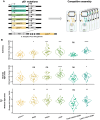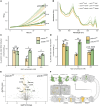Enhancing photosynthesis under salt stress via directed evolution in cyanobacteria
- PMID: 40397698
- PMCID: PMC12127731
- DOI: 10.1093/plphys/kiaf209
Enhancing photosynthesis under salt stress via directed evolution in cyanobacteria
Abstract
A key aspect of enhancing photosynthesis is improving the kinetics of photochemical quenching recovery following environmental perturbation or stress. Salt stress exacerbates high light stress in cyanobacteria and leads to severe yield losses in crop plants. Genetic traits that confer salt tolerance without compromising photosynthetic performance are essential for improving photosynthesis under these conditions. Here, we applied accelerated evolution in Synechococcus elongatus PCC 7942 by conditionally suppressing its methyl-directed mismatch repair system to obtain beneficial genetic traits for enhanced photosynthesis under salt stress. We screened over 10,000 mutants and isolated 8 strains with increased biomass or sucrose productivity under salt stress. Genome sequencing revealed an average of 8 to 20 single nucleotide polymorphisms or indels per genome. Notably, mutations in the photosystem II (PSII) reaction center D1-encoding gene, resulting in the amino acid changes L353F, I358N, and H359N at the carboxyl terminus of the precursor-D1 (pD1) protein, improved photosynthesis under salt and combined salt and light stress by potentially accelerating D1 maturation during PSII repair. Phylogenetic analysis of pD1 across cyanobacteria and red algae highlights the broad relevance of these adaptive genetic traits, underscoring the importance of leveraging evolutionary insights to improve photosynthesis under stress or fluctuating environments.
© The Author(s) 2025. Published by Oxford University Press on behalf of American Society of Plant Biologists.
Conflict of interest statement
Conflict of interest statement. X.W. and Z.J. are listed as inventors in a patent application (application no. 18/400,586) for applying the high-throughput screening method to uncover genetic traits for photosynthesis improvement. X.W. is listed as the inventor for another provisional patent application (application no. 63/655,889) to apply pD1 mutations to improve photosynthesis and plant growth. The remaining authors declare no competing interests.
Figures






Similar articles
-
A Specific Single Nucleotide Polymorphism in the ATP Synthase Gene Significantly Improves Environmental Stress Tolerance of Synechococcus elongatus PCC 7942.Appl Environ Microbiol. 2018 Aug 31;84(18):e01222-18. doi: 10.1128/AEM.01222-18. Print 2018 Sep 15. Appl Environ Microbiol. 2018. PMID: 30006407 Free PMC article.
-
Natural variants of photosystem II subunit D1 tune photochemical fitness to solar intensity.J Biol Chem. 2013 Feb 22;288(8):5451-62. doi: 10.1074/jbc.M112.394668. Epub 2012 Dec 27. J Biol Chem. 2013. PMID: 23271739 Free PMC article.
-
Physiological, Photosynthetic Characteristic and Transcriptome Analysis of PsnWRKY70 Transgenic Populus simonii × Populus nigra Under Salt Stress.Int J Mol Sci. 2024 Dec 25;26(1):81. doi: 10.3390/ijms26010081. Int J Mol Sci. 2024. PMID: 39795940 Free PMC article.
-
Cyanobacterial psbA gene family: optimization of oxygenic photosynthesis.Cell Mol Life Sci. 2009 Dec;66(23):3697-710. doi: 10.1007/s00018-009-0103-6. Epub 2009 Jul 31. Cell Mol Life Sci. 2009. PMID: 19644734 Free PMC article. Review.
-
Recent advances in understanding the assembly and repair of photosystem II.Ann Bot. 2010 Jul;106(1):1-16. doi: 10.1093/aob/mcq059. Epub 2010 Mar 25. Ann Bot. 2010. PMID: 20338950 Free PMC article. Review.
References
-
- Allakhverdiev SI, Nishiyama Y, Miyairi S, Yamamoto H, Inagaki N, Kanesaki Y, Murata N. Salt stress inhibits the repair of photodamaged photosystem II by suppressing the transcription and translation of psbA genes in Synechocystis. Plant Physiol. 2002:130(3):1443–1453. 10.1104/pp.011114 - DOI - PMC - PubMed
-
- Andrews S. FastQC: a quality control tool for high throughput sequence data. Cambridge, UK: Babraham Bioinformatics; 2010. http://www.bioinformatics.babraham.ac.uk/projects/fastqc/
MeSH terms
Substances
Supplementary concepts
Grants and funding
LinkOut - more resources
Full Text Sources

